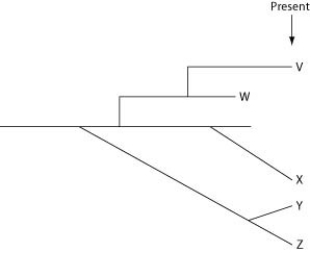Multiple Choice
The question refers to the following evolutionary tree, in which the horizontal axis represents time (present time is on the far right) , and the vertical axis represents morphological change.  Which conclusion can be drawn from this evolutionary tree?
Which conclusion can be drawn from this evolutionary tree?
A) A single clade (that is, a group of species that share a common ancestor) can include species that formed by gradualism and other species that formed by punctuated equilibrium.
B) A single clade (that is, a group of species that share a common ancestor) will either include species that formed by gradualism or species that formed by punctuated equilibrium.
C) Assuming that the tip of each line represents a species, there are five extant (that is, not extinct) species resulting from the earliest common ancestor.
D) Species X and Z best represent species that evolved by punctuated equilibrium.
Correct Answer:

Verified
Correct Answer:
Verified
Q10: According to the biological species concept, for
Q12: Two species of tree frogs that live
Q14: Use the following information to answer the
Q15: There is still some controversy among biologists
Q16: Beetle pollinators of a particular plant are
Q29: Plant species A has a diploid number
Q33: Bird guides once listed the myrtle warbler
Q42: A hybrid zone is properly defined as
Q53: According to the concept of punctuated equilibrium,
Q60: In a hypothetical situation, a certain species